
Which Saucepan Should You Use?
Saucepan Sizes
Choosing Saucepan Sizes: Capacity
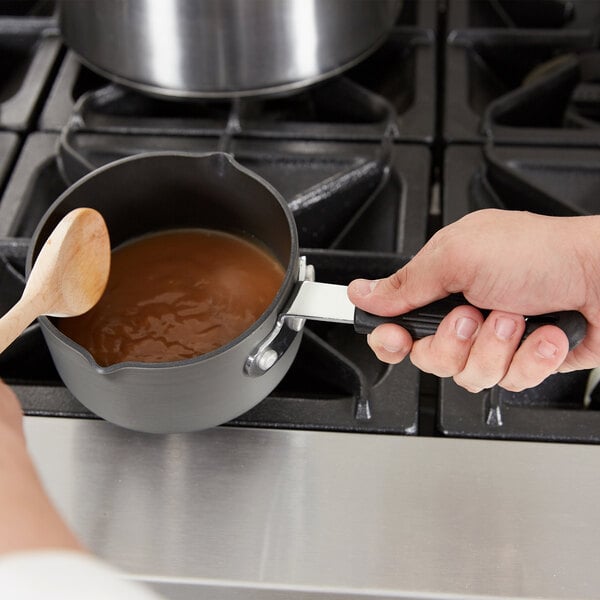
Small Capacity
Generally recommended for small cafes and delis, though it can be kept on hand by large institutes for whipping up a small specialty meal. Can be used for individual servings without fear of cross-contamination.
- 1-2.75 qt.
- Use for small portions of soups, sauces, and gravies. Also, use for individual servings like a gluten-free dessert for one or two guests.
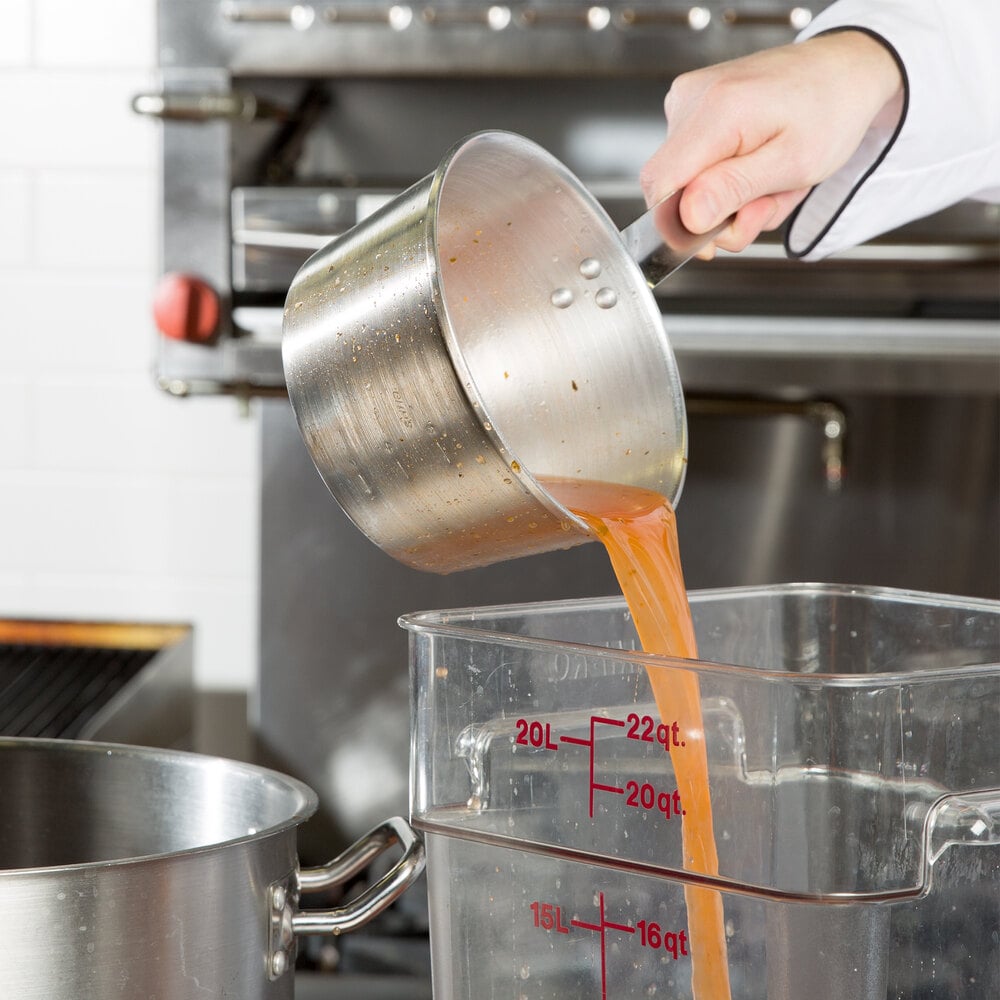
Medium Capacity
Medium is just the right size to handle a substantial amount of food without being overly large for its purpose. All establishments from large to small should have a medium-sized saucepan since it provides such flexibility in the kitchen.
- 3-4.5 qt.
- Use to handle multiple servings of grains, mashed potatoes, and blanched vegetables as well as a heavy custard or cream topping.
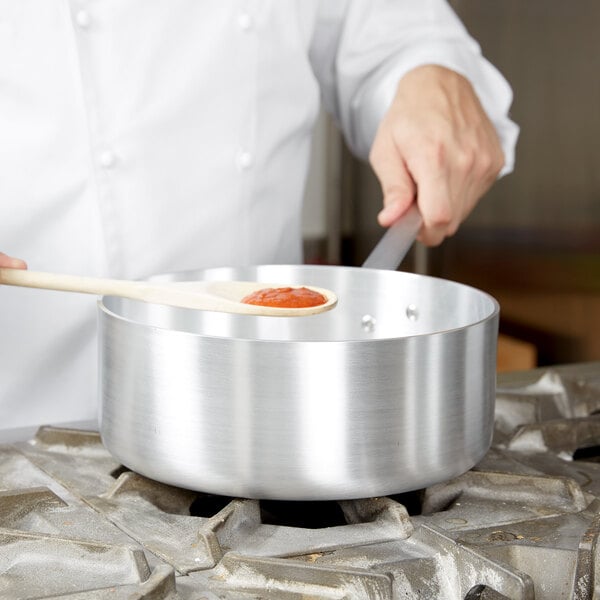
Large Capacity
Large pans are ideal for cooking in bulk as the size is only applicable for creating food en masse. Casual to upscale restaurants, pizzerias, and catering companies will definitely benefit from having a large saucepan on hand and ready to tackle meals for many people at once.
- 5-7 qt.
- Use for making pasta sauce, chicken stock, or a specialty soup.
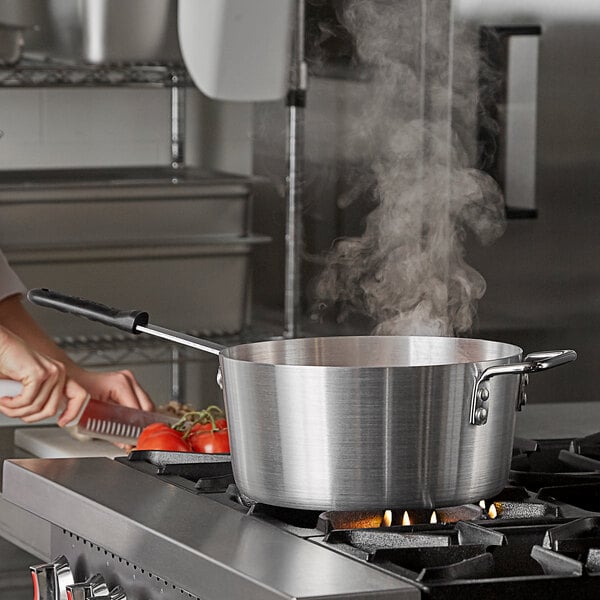
Extra Large Capacity
Especially ideal for eateries that serve one or two main dishes, extra large saucepans are great for cooking food for a lot of people, or for cooking a portion of a meal, like a pasta sauce, that will be used in many dishes. Cafeterias, hospitals, and schools will benefit from the extra large size of these saucepans, but typical restaurants will also benefit from being able to cook one or two bulk specialty foods that sell quickly in these large pans.
- 7 qt. +
- Use for making large quantities of stew, pasta sauce, blanching larger vegetables, or steaming lobster.
Choosing Saucepan Sizes: Diameter
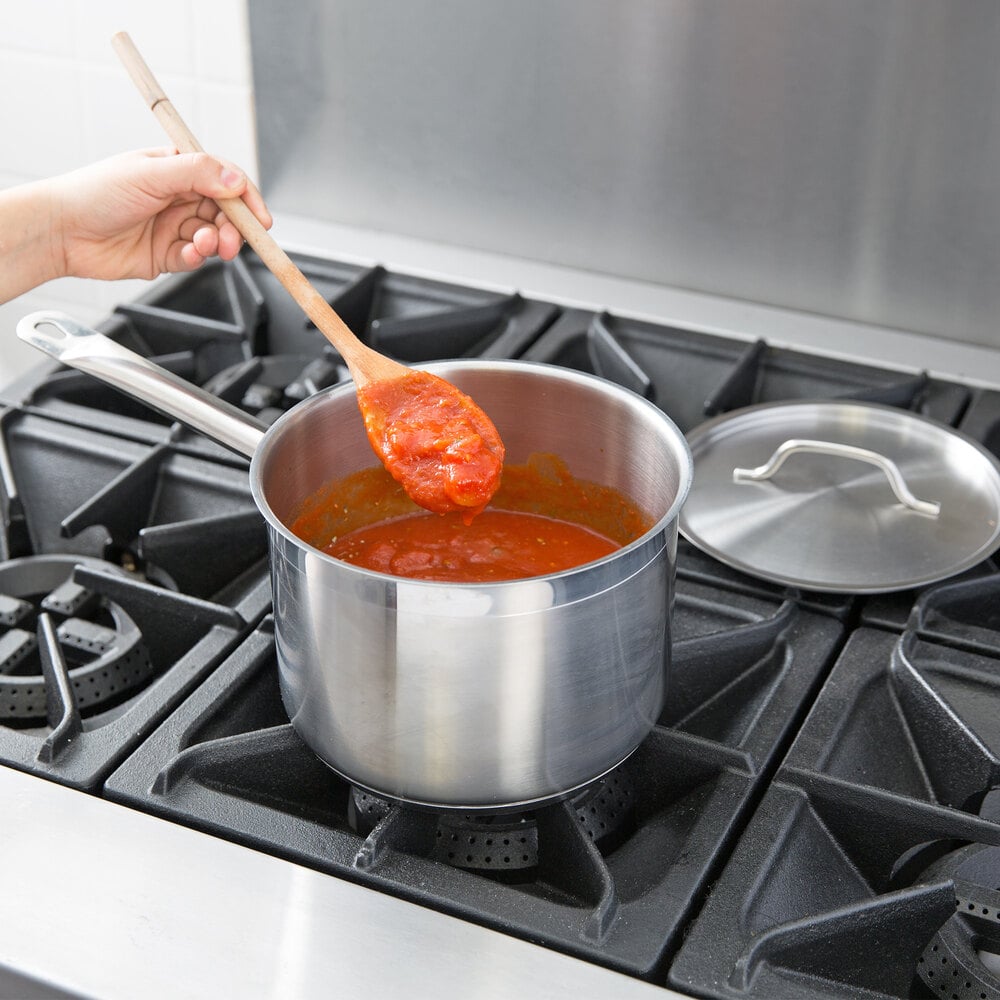
Narrow
- Less food touches the hottest part of the pan
- Food retains more moisture due to the narrow diameter

Wide
- Wide pans heat more quickly and evenly
- Acts as a large cooking surface, so it's perfect for braising
Choosing Saucepan Sizes: Side Style

- Provide better heat conduction for more versatile cooking
- Pair the pan with a lid to accelerate cooking
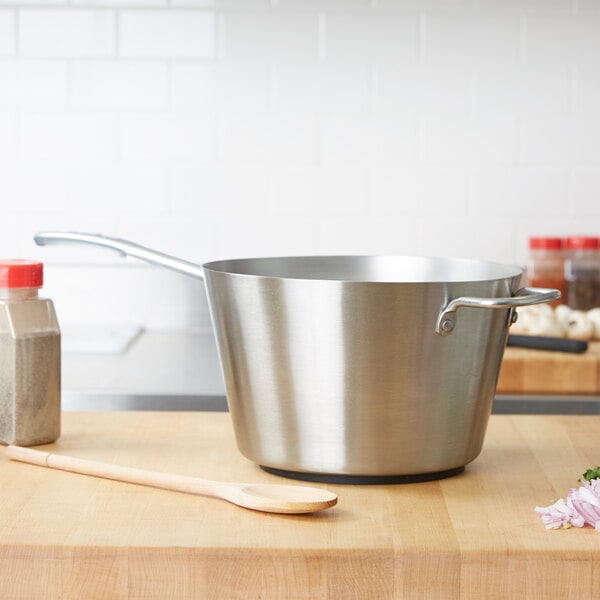
- Flared sides give the pan a shape ideal for stirring
- Use when cooking food that needs to be at a consistent low temperature
Compare Saucepan Materials
With a standard silver color, aluminum pans are a popular economical option perfect for start-up restaurants, cafes, and diners.
- Lightweight
- Excellent heat conductor
- May discolor light-colored food
- Less durable than other options
Stainless steel pans also have that standard silver color while adding extra durability and weight that aluminum pans simply can't compete with.
- Nonreactive
- Extremely durable and rust-resistant
- Induction ready
- Prone to hot spots / scorching
- Heavy weight
Most often used for display cooking, copper saucepans have a distinctive orange-red color. They will occasionally have a stainless steel handle to ensure reliable transportation.
- Best heat conductor
- Visually appealing for display cooking
- Most expensive option
- Reacts chemically with some foods
- Easily dented
These saucepans are made of stainless steel but have a few millimeters of aluminum permanently adhered to the bottom to better distribute heat.
- Distributes heat evenly and effectively
- Heavy weight
Just the opposite of aluminum-clad pans, stainless steel-clad means the pan is made of aluminum and there is a few millimeters of stainless steel on the bottom of the pan.
- More lightweight than all-stainless steel options
- Induction ready
- Poor heat conductor
- Prone to hot spots / scorching
With its main feature obviously being a non-stick surface, these pans typically have a black interior for easy identification. This interior is a coating of PTFE, or Teflon®.
- Coating prevents foods from sticking
- Prevents burnt-on food
- Dark color disguises the true color of the food, which can lead to over-browning
- Easy to scratch
Tri-ply means that there are three layers of material: the outer two layers made of stainless steel and the interior layer, or "core," made of aluminum. Some saucepans only have the tri-ply construction on the bottom, the rest of the pan having a typical single-layer construction, while other pans have the tri-ply design on the bottom and sides.
- Nonreactive
- Induction ready
- Improved heat conduction
- Heavy weight

Induction cooking uses magnetism to generate heat. If you are unsure if you have an induction saucepan, just trying putting a magnet on the bottom of your pan! If the magnet sticks, you can use the pan on any induction surface.
Handle Options for Saucepans
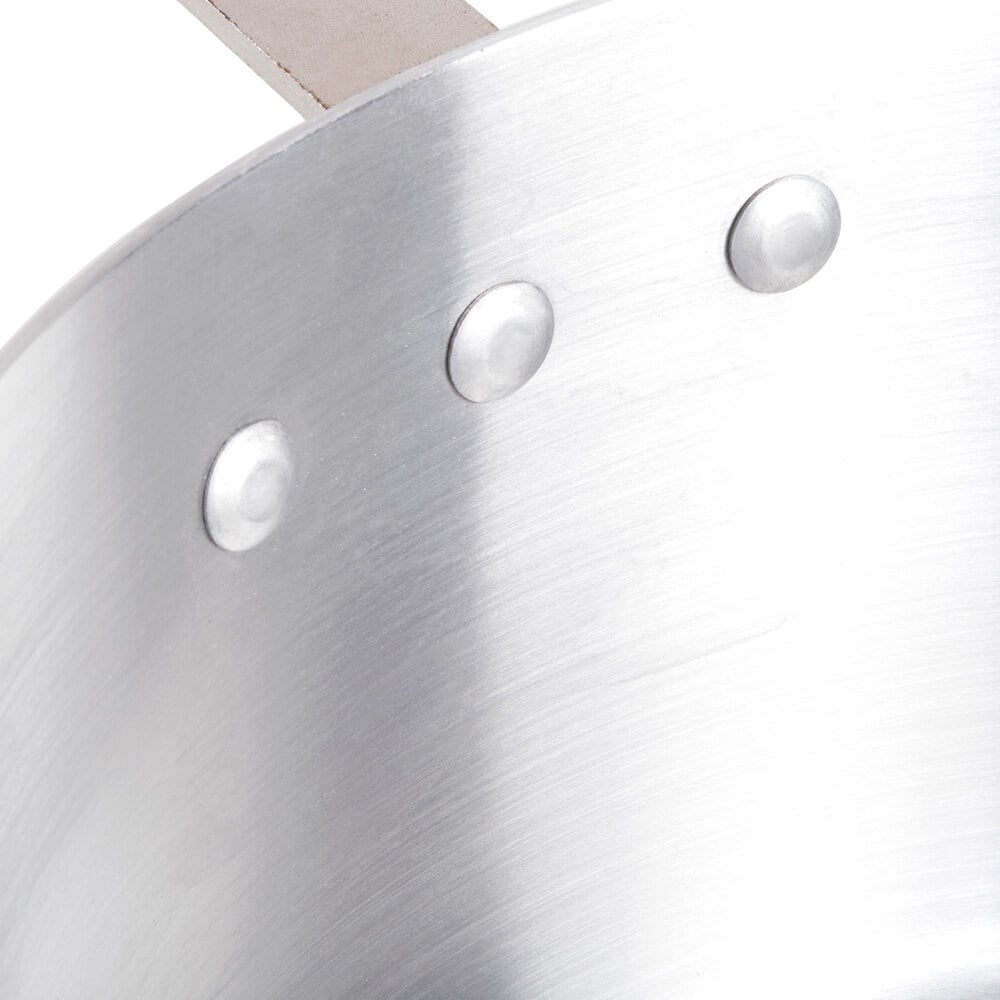
Riveted Handle
Usually connected by 2 or 3 pieces of hardware, or rivets, this handle provides an excellent connection between the handle and pan. However, these rivets can easily catch or hold food, which makes cleaning more difficult. So while riveted handles are the most sturdy option, it is less sanitary than a welded handle. It is suggested to choose this type of handle for your heavy pans.
- Strongest connection; made to last in commercial environments
- Difficult to clean; can house bacteria

Welded Handle
This handle is melted or welded to the pan during construction to provide a sturdy connection. The process results in a completely smooth interior on the pan and no space or crevices for food or bacteria to get stuck. It is ultimately less sturdy than a riveted handle, but it's more sanitary. It's best to choose these handles for medium- to light-duty pans.
- Sanitary and easy to clean
- Connection is less secure when handling heavy pans

Helper Handle
A helper handle is a loop handle placed opposite the long handle on a pan. This extra handle lets you steady a pan during transport to put less strain on the main handle as well as less strain on your chef's wrist. Since it's designed to help carry heavy foods, you will primarily only see this handle on larger pans.
- Provides extra support
- Takes up more space during storage and while on a stove top

Hollow Handle
Air is one of the best insulators out there - hollow handles take advantage of this by creating a hollow tube that stays cool much longer when connected to a saucepan. These handles are better insulated than the typical solid metal handles you'll see. Likewise, they are lighter in weight and so contribute to an overall lighter pan.
- Stays cooler while cooking
- Will not fit typical handle covers
Consider the Weight of Your Saucepan
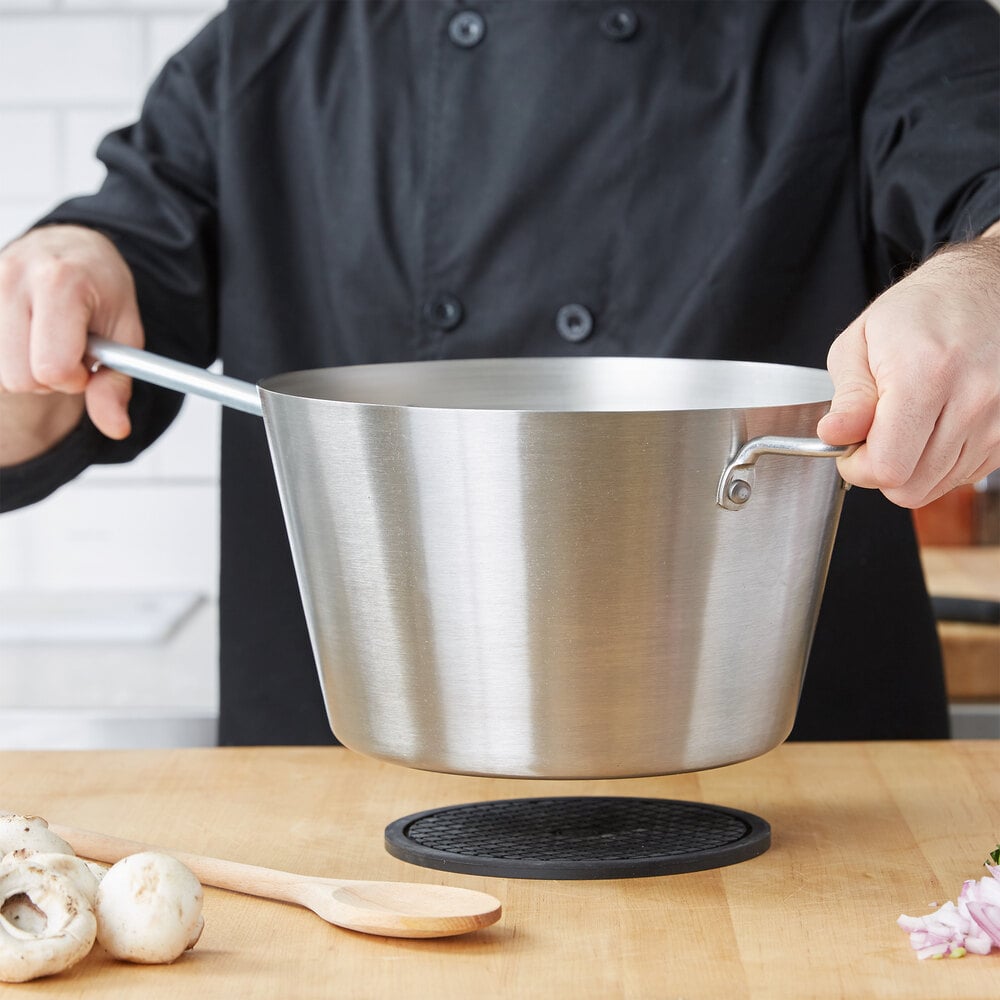
The weight of a pan relies on:
- Material
- Material Thickness
- Desired Size
Getting a lightweight pan is great for your chefs and dishwashers as the lighter pan is easy to maneuver, even when filled with food. The trade-off is that lightweight pans tend to have a thinner construction, which is easier to bend or ding. In some cases, if the rim is bent a lid will no longer fit on the pan.
However, a heavy saucepan will not be easily dented so you can count on long-lasting durability. The compromise here is that chefs may struggle to lift and carry heavy pans filled with heavy foods around the kitchen. To help with this, try getting a pan that has a helper handle to help offset the weight while carrying.
Saucepan Thickness
The advantage of a thin pan is the economical price point, the fast heat times, and the lightweight feel. But the thicker the pan, the more durable it is and the longer it is likely to last in fast-paced environments where pans get dropped, bumped, and generally abused in everyday use.
How is a Saucepan Different?
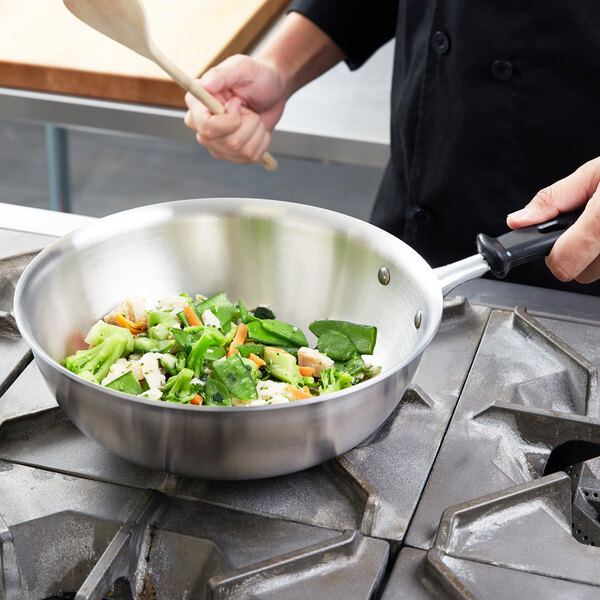
Sauciers vs. Saucepans
- A saucier pan has sides that slope down to a rounded bottom whereas a saucepan has straight sides that connect at an angle to a flat bottom.
- Saucier pans are better for stirring or whisking as foods won't get stuck in corners.
- Use these to prepare custards, sauces, and creamy soups and foods.
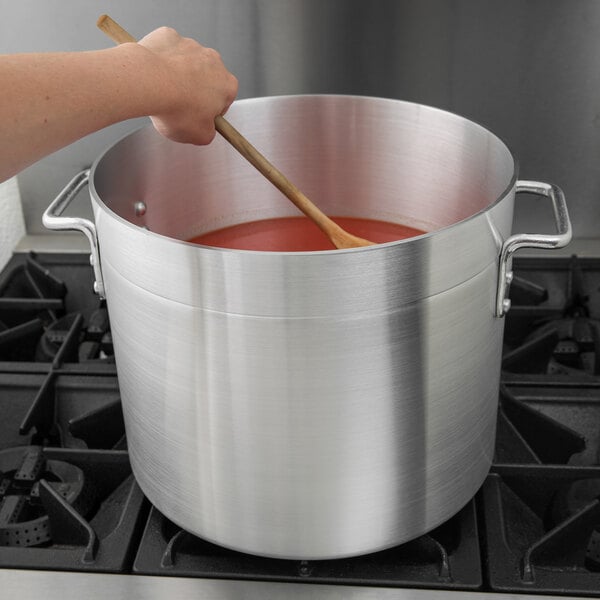
Stock Pots vs. Saucepans
- Stock pots have the same straight-sided design as saucepans.
- They have a handle on either side of the pot rather than a long handle for easier transportation.
- With large capacities ranging to over 100 qt., they can handle high volumes of soups, tomato sauces, and broths.
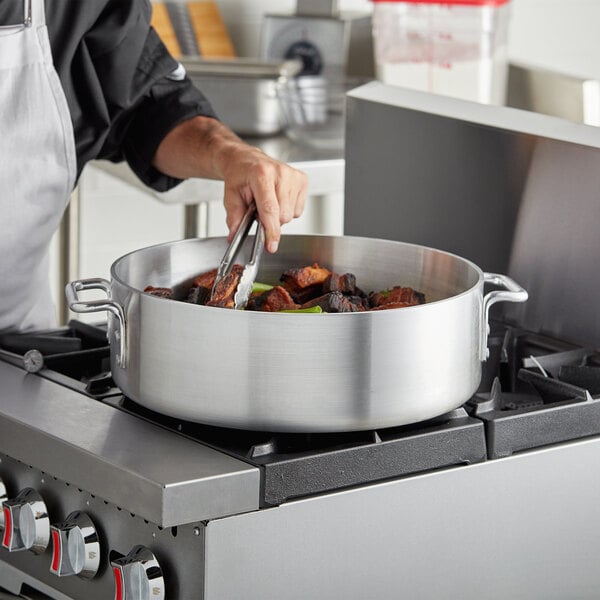
Braziers vs. Saucepans
- A brazier is similar in design to a saucepan, however it is wider and more shallow in shape.
- It also has two handles rather than a long handle like a saucepan, and it is typically sold with a lid.
- Braziers are used to brown, sear, and fry items more easily than a saucepan can since it has a large capacity and a large bottom diameter.
Related Resources
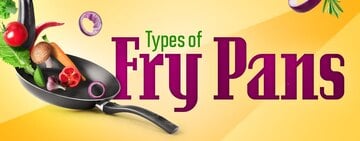
Types of Fry Pans
Frying pans are one of the most used and versatile pieces of cookware in the kitchen. They are great for cooking a wide range of foods, from eggs and pancakes to thick steaks, so having the correct types in your arsenal is necessary. You may already know all the types out there, but which frying pan type is the best for you? This guide will go over the best types of frying pans for a commercial kitchen and how to use and care for them to help make your decision easier. Shop All Frying Pans Use the following links to navigate this guide and learn more about frying pans: What Is a Frying Pan? Frying Pan Types Non-Stick Pan vs Stainless Steel Frying Pan Sizes
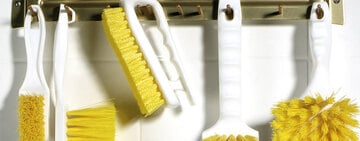
Types of Pot and Pan Scrub Brushes
Good food requires three things: fresh ingredients, a skilled chef, and most of all, clean pots and pans. Think about it: You could have an Iron Chef cooking with fresh produce from his or her own garden, but if the pots and pans are a mess, the food will be too. That means the most important kitchen tool should be a good, old fashioned scrub brush . Without one, you can say goodbye to tasty dishes that will keep customers coming back. This guide gives you a place to start, providing the basics of pot and pan scrub brushes, so you can make an informed decision and successfully upgrade your kitchen.
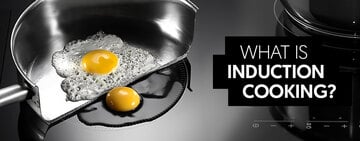
What Is Induction Cooking?
Whether you're building a brand new restaurant or looking to remodel, it's important to consider your options when it comes to what type of cooking equipment will be best for your business. Induction cooking has grown in popularity over the years, but the way it works and the benefits of using it are still a mystery to many. Keep reading to learn what induction cooking is and why it's a popular choice amongst many restaurateurs. What Is an Induction Cooktop? An induction cooktop is a cooking surface that heats by transferring currents from an electromagnetic field located below the glass surface directly to the magnetic induction cookware placed above. Unlike thermal conduction, it heats this cookware directly without the need for a flame o
- Topics 1346
- Industrial 55
- Troubleshooting Guides 21
- Restaurant Management 128
- Bar Management 55
- Catering Tips 35
- Bakery Management 42
- Food Trucks & Concessions 49
- Advertising & Marketing 37
- Eco-Friendly Tips 11
- Facility Layout & Design 41
- Coffee Shop Tips 28
- Installation & Maintenance 51
- Janitorial & Pest Control 30
- Safety & Sanitation 88
- Startup Tips 104
- Menu Design 10
- Kitchen & Cooking Tips 81
- Hospitality Management 23
- Pizza & Sandwich Shop Tips 36
- Smallwares 37
- Food Prep 88
- Tabletop Items 17
- Disposables 22
- Calculators & Tools 6
- Consumables 52
- Warewashing & Laundry 18
- Cooking Equipment 90
- Food Storage & Refrigeration 51
- Beverage Equipment 34
- Office Supplies 6
- Resource Type
- In-Depth Articles272
- Buying Guides296
- How-Tos93
- Product Reviews77


